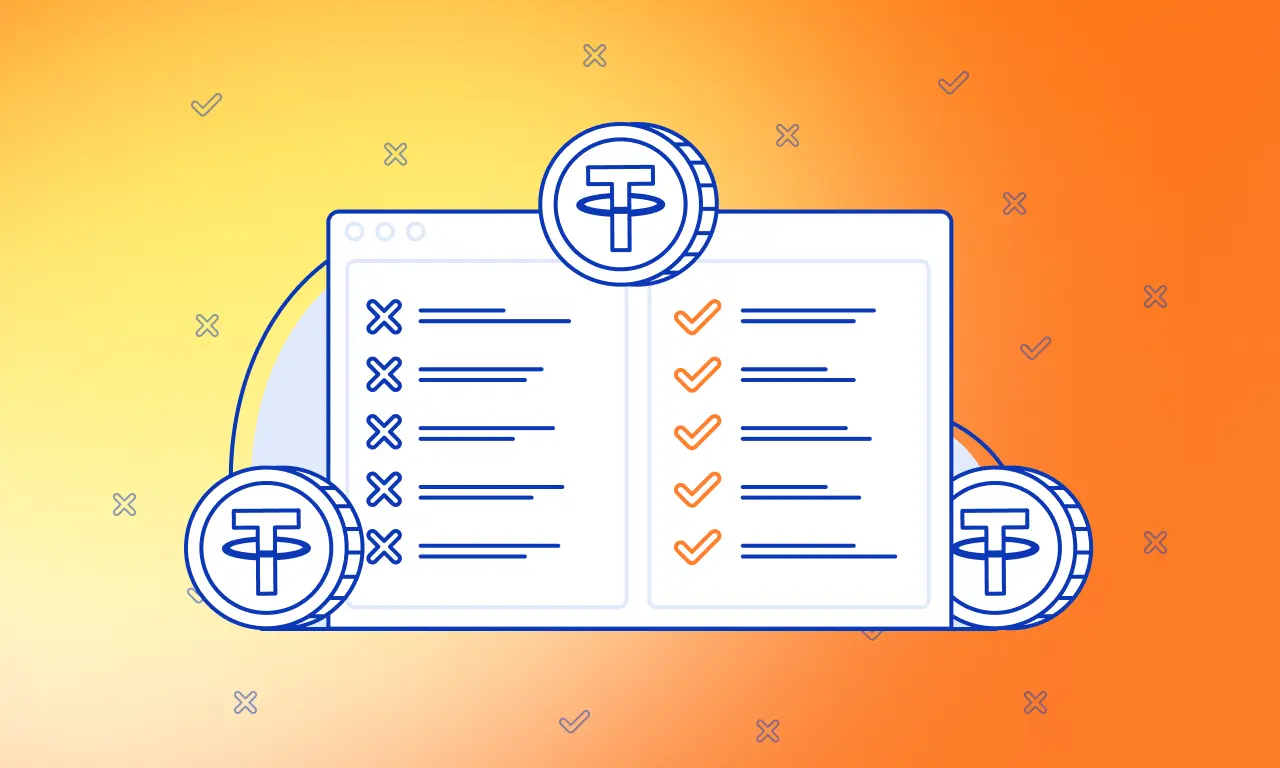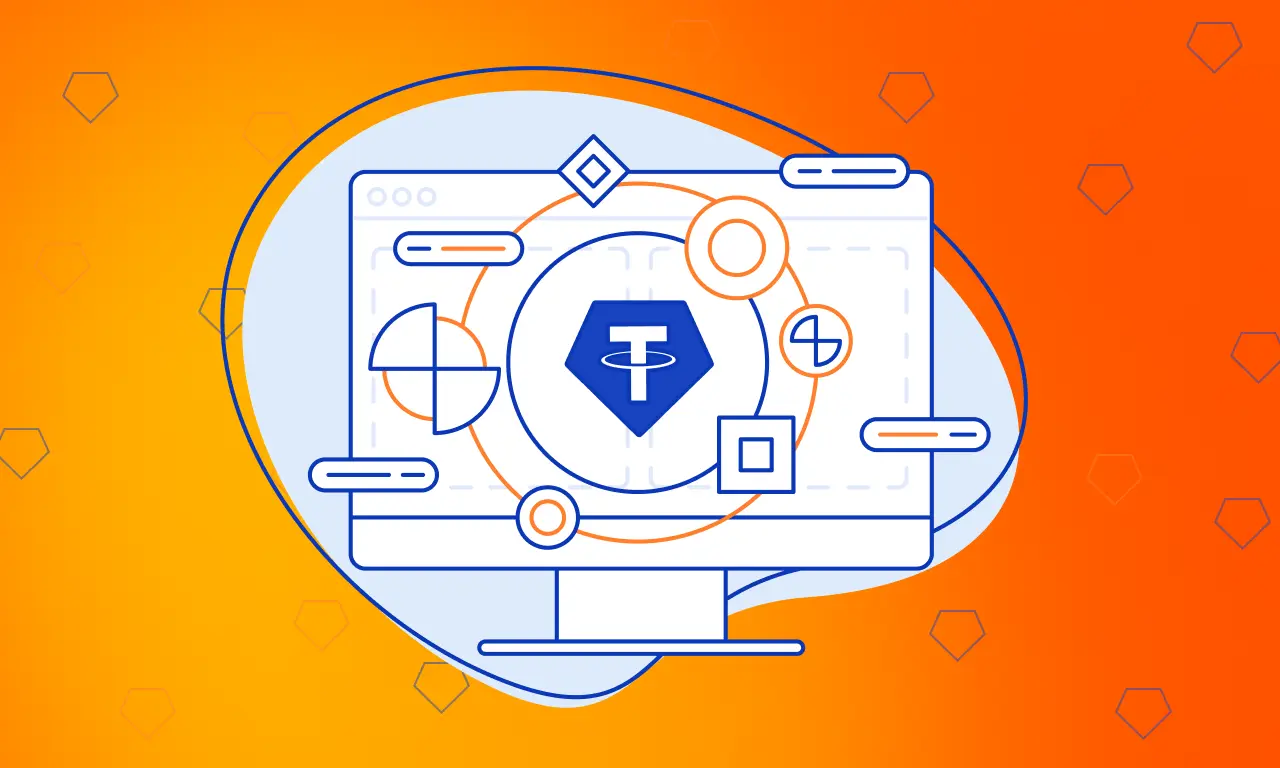USDT Overview: How to Pay and Which Network to Choose?
04/09/2023

USDT (Tether) is a stablecoin created to provide users with price stability in the volatile cryptocurrency market. The history of Tether began in 2012 when programmer J.R. Willet proposed a solution for creating new cryptocurrencies based on Bitcoin. Based on this solution, the Mastercoin token was released on July 31, 2013. In order to promote the Mastercoin protocol (later renamed the Omni Layer Protocol), the Mastercoin Foundation was created, with Bitcoin Foundation Chairman Brock Pierce as one of its founders and programmer Craig Sellars as its CTO.
In July 2014, Pierce, Sellars, and advertising industry entrepreneur Reeve Collins launched the Realcoin startup based in Santa Monica, USA. On October 6, 2014, the company issued Realcoin tokens based on Bitcoin and using the Omni Layer protocol. On November 20, 2014, Realcoin CEO Reeve Collins announced the project's rebranding as Tether. The creators of the project wanted to avoid association with altcoins.
One of the main advantages of USDT is its stability. As mentioned earlier, the price of USDT is pegged to the US dollar, making it a more predictable and reliable means of payment. This is especially important for users who do not want to risk their funds in the volatile cryptocurrency market.
In addition, USDT allows users to quickly and conveniently transfer money around the world. Since USDT operates on the blockchain, transfers can be made without intermediaries, speeding up the process and reducing fees. This makes USDT an attractive means of payment for users who want to send money quickly and reliably across borders and beyond.
USDT also provides users with broader trading opportunities on cryptocurrency exchanges. Since USDT is pegged to the US dollar, users can easily convert their cryptocurrencies into USDT to protect their funds from market volatility. This makes USDT a useful tool for users who want to protect their funds from fluctuations in cryptocurrency prices.
Overall, USDT is a useful tool for cryptocurrency users who seek stability and reliability in the volatile market. It provides users with broad opportunities for money transfers, trading on cryptocurrency exchanges, and protecting their funds from price fluctuations.

The distinctive nature of USDT: its operation and mechanisms
The main difference between this stablecoin and Bitcoin (and other cryptocurrencies) is that it does not have transaction blocks and is backed by reserves of fiat currency. In other words, Tether does not have its own blockchain. Ready-made decentralized systems are used to implement the tokens. USDT can be purchased by transferring money to Tether Limited's accounts.
The functioning of this stablecoin is supported by various open protocols. One of them is the Omni Layer. It is needed to interact with the Bitcoin blockchain, as well as to issue and redeem USDT based on it.
It is worth noting the consensus principles of different currencies:
- Fiat money uses the Proof of Solvency principle - proof of solvency.
- Cryptocurrency operates on Proof-of-Work (proof of work), Proof-of-Stake (proof of stake), or other variations.
- In the case of Tether, the Proof of Reserves method is used - proof of reserves.
The essence of this format of operation is reduced to two processes:
- The sum of tokens is verified on the Bitcoin blockchain. Standard tools in open access are used for this.
- The total value of tokens is confirmed by dollar reserves in bank accounts. Independent auditors carry out periodic checks to monitor the situation.
The amount of available funds Tether Limited publishes on its official website.

Advantages and disadvantages of USDT
One of the drawbacks of USDT is the risks associated with reserve problems. There is a lot of information on the network that Tether Limited has reserves for only about 70% of the created tokens. In the company's official documentation, it is stated that USDT is not a payment instrument or money. For this reason, the issuer has no obligation to exchange its token for dollars. Also, it does not guarantee that USDT will be exchanged on other platforms.
| Benefits | Drawbacks |
| Stability. USDT is pegged to the US dollar, ensuring price stability. | Centralized Control. USDT is governed by a single entity (Tether, Inc.), which may raise concerns about transparency and reserve assets. |
| Liquidity. USDT is widely accepted and available on numerous cryptocurrency exchanges, providing high liquidity. | Regulatory Risks. Regulatory authorities can intervene in the operation of USDT, potentially affecting its usage. |
| Fast Transactions. USDT transfers can be conducted quickly and with low fees. | Lack of Complete Decentralization. USDT is not fully decentralized, which can introduce certain risks. |
| Convenience in Trading. USDT is used as a base pair on many exchanges, facilitating trading and arbitrage. | Account Freezing Possibility. In some cases, accounts associated with USDT can be frozen. |
| Widespread Adoption. USDT is accepted and utilized in various payment systems and services. | Dependency on the US Dollar. USDT is entirely dependent on the value of the US dollar and may be subject to currency fluctuations. |
Although it is believed that the value of USDT is always equal to $1, there are sometimes noticeable fluctuations:
- In April 2017, the USDT rate dropped to $0.91 at one point;
- In December of the same year, the value of Tether reached $1.10.
But such jumps occur very rarely. Mostly, the stablecoin rate really corresponds to the declared $1. And the size of deviations rarely exceeds 1%.
Large investors should pay attention to such nuances. If at some point the stablecoin loses its backing, its holders may incur losses. But this is only a theoretical risk, as at the moment USDT is one of the most popular tokens.
In addition, for many participants in the cryptocurrency community, a significant drawback is the lack of full anonymity and the inability to mine.

Overview of USDT networks
Initially, USDT tokens were only issued on the basis of Bitcoin using the Omni Layer protocol.
Omni Layer is a platform implemented as a software layer on top of the Bitcoin blockchain. It allows for the creation, transfer, tracking, exchange, and destruction of Tether tokens. Each Omni transaction and, accordingly, Tether transaction is recorded in the Bitcoin blockchain with the same hash.
Currently, Tether tokens are issued on the Ethereum blockchain in the ERC-20 format, on the TRON network using the TRC-20 protocol, as well as on EOS, Algorand, and Liquid Network.
USDT on Ethereum is known as Tether ERC-20 and operates on the ERC-20 standard. This allows USDT to be used on Ethereum as a token for smart contracts and other decentralized applications. Ethereum is one of the most popular blockchain networks, making USDT on Ethereum more liquid and available for use on various cryptocurrency exchanges.
USDT on Tron is known as Tether TRC-20 and operates on the TRC-20 standard. The Tron network is known for its high speed and low transaction fees, making USDT on Tron an attractive option for users who want to quickly and inexpensively transfer USDT. Also, thanks to the active Tron ecosystem, users can easily exchange USDT on Tron on various decentralized exchanges and use it in various applications.
USDT on Omni operates on its own Tether protocol. Omni was the first blockchain network on which USDT was launched. The Omni Layer allows for the creation, transfer, tracking, exchange, and destruction of Tether tokens. USDT on Omni has a high degree of reliability and security, making it a preferred choice for users who want to hold USDT long-term.
USDT is also available on other blockchain networks such as EOS, Algorand, and Liquid Network. Each of these networks has its own features and advantages that may be attractive to different users depending on their needs and preferences.
Overall, having USDT on different blockchain networks allows users to choose the appropriate platform for their needs and provides more opportunities for using and exchanging this stablecoin.

Advantages of using USDT for payments
Using the cryptocurrency USDT for making payments has several advantages that make this stablecoin an attractive means for transactions and financial operations.
Eliminating the need for currency exchange:
One of the difficulties with international payments is the need for currency exchange. With USDT, this step becomes unnecessary, as the cryptocurrency already has a stable peg to the US dollar. This avoids losses from exchange operations and saves time.
Support for multiple payment systems:
USDT is integrated into multiple payment systems and gateways, making it easier to receive and send payments for various online services, e-commerce sites, and other payment platforms.
Price stability:
One of the main advantages of USDT is its stable price pegged to the US dollar. This means that the value of 1 USDT will always be close to 1 dollar, providing predictability and minimizing the risks of significant price fluctuations.
Simplifying international trade:
For businesses engaged in international trade, USDT provides a tool that simplifies payments between different countries and currencies. This also helps eliminate the need for complex exchange operations.
These and many other factors make USDT an attractive and stable choice for those seeking an efficient, convenient, and reliable means for payments and trading in today's financial realities.

How does Tether work?
USDT cannot be considered an investment instrument. The token plays more of a role as a reliable storage of existing funds.
The Tether issuance scheme is simple, as USDT is a dollar-backed stablecoin. How does it work? Let's say an investor wants to start trading on an exchange, buying and selling cryptocurrencies, etc. They have US dollars but no cryptocurrencies. To do this, they should open an account with Tether Limited and transfer their dollars to their deposit. After that, the company creates USDT in an equivalent amount and places them in the user's account. Then the user performs operations with their USDT on the exchange. At some point, the user decides to withdraw their money back to fiat. To do this, they sell their cryptocurrency for USDT, then transfer the USDT to their account with Tether Limited, and the company transfers US dollars to their fiat account in an equivalent amount.
Conclusion
Tether is a truly significant and practical asset that harmoniously combines the best characteristics of cryptocurrencies and fiat money. Thanks to its features, it has gained huge popularity in the cryptocurrency community. Traders constantly use it in their trading, while ordinary users use it for peer-to-peer payments.
Do you like this article? Share it with your friends.




